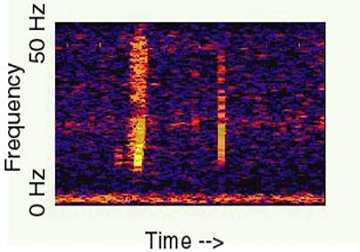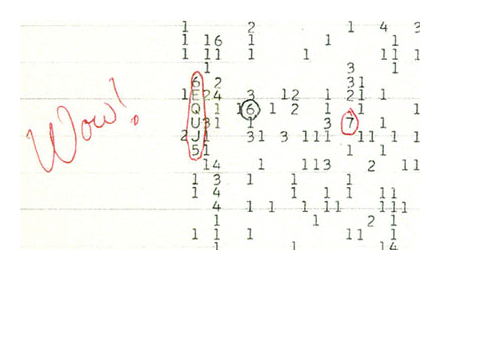During the Cold War, the United States Navy erected a vast array of underwater listening devices in order to detect and track Soviet nuclear submarines. These hydrophones were placed at roughly 3,000 mile intervals in the deep layer of water known as the deep sound channel, where cold temperatures and high pressures allow sound waves to propagate great distances. When the Cold War ended, rather than mothballing the Sound Surveillance System (SOSUS), the U.S. Navy lent the Cold War relic to science.
The array has since been used to track many fascinating undersea events, such as whale migrations, earthquakes, ocean currents, volcanic activity , and the shifting of Antarctic ice. But one sound captured by the sensitive SOSUS hydrophones has scientists puzzled. It fits the profile of a living creature, but for a creature to create this sound it would have to be significantly larger than a blue whale, which is believed to be the largest animal ever to have lived.The unexplainable sound was detected several times during the summer of 1997, originating off the South American southwest coast at about 50° S 100° W. Each time that it was captured the ultra-low frequency sound rose rapidly in frequency over about one minute, and had sufficient amplitude to be heard on multiple sensors from over 3,000 miles away. Perplexed researchers, unable to identify any possible source for the sound, dubbed it “The Bloop.”
The sound shares many characteristics with those emanated from biological creatures, in fact it fits those parameters so closely that a large number of researchers are convinced that its origin is animal. But in order for an aquatic animal to emit a sound that can travel over 3,000 miles through Earth’s noisy oceans, scientists say that it would need an incredibly large noise-making apparatus, one much bigger than that of the blue whale.
The array has since been used to track many fascinating undersea events, such as whale migrations, earthquakes, ocean currents, volcanic activity , and the shifting of Antarctic ice. But one sound captured by the sensitive SOSUS hydrophones has scientists puzzled. It fits the profile of a living creature, but for a creature to create this sound it would have to be significantly larger than a blue whale, which is believed to be the largest animal ever to have lived.The unexplainable sound was detected several times during the summer of 1997, originating off the South American southwest coast at about 50° S 100° W. Each time that it was captured the ultra-low frequency sound rose rapidly in frequency over about one minute, and had sufficient amplitude to be heard on multiple sensors from over 3,000 miles away. Perplexed researchers, unable to identify any possible source for the sound, dubbed it “The Bloop.”
The sound shares many characteristics with those emanated from biological creatures, in fact it fits those parameters so closely that a large number of researchers are convinced that its origin is animal. But in order for an aquatic animal to emit a sound that can travel over 3,000 miles through Earth’s noisy oceans, scientists say that it would need an incredibly large noise-making apparatus, one much bigger than that of the blue whale.
Theories abound as to the source of the Bloop. If it is the vocalization of a living organism, it is one which makes its home in the dark, cold depths of the ocean. Some have suggested that giant squids could be responsible for the sound, but that is unlikely considering that no known species of cephalopod have the gas-filled sac necessary to reach such great volumes. Indeed science has not recorded any animals– living or extinct– with nearly enough size to house the organs needed to produce the level of output demonstrated by the Bloop… so unless this mystery creature uses some unknown mechanism to generate sound, it is presumed to be an incredibly massive organism.
Further study of the Bloop is hampered by the fact that it has not been heard since the summer of ’97. It is almost certain that unseen creatures still lurk in the deep and dark oceans, creatures which are strange and fascinating. Such an unknown animal may have uttered these sounds while lingering at an unusually shallow depth. Unless researchers encounter the sound again, there is little chance that we’ll have any explanation more concrete than scientific speculation. But given its unusual properties and strong indications of a large biological origin, it makes for a compelling mystery.
http://www.damninteresting.com/the-call-of-the-bloop/
Further study of the Bloop is hampered by the fact that it has not been heard since the summer of ’97. It is almost certain that unseen creatures still lurk in the deep and dark oceans, creatures which are strange and fascinating. Such an unknown animal may have uttered these sounds while lingering at an unusually shallow depth. Unless researchers encounter the sound again, there is little chance that we’ll have any explanation more concrete than scientific speculation. But given its unusual properties and strong indications of a large biological origin, it makes for a compelling mystery.
http://www.damninteresting.com/the-call-of-the-bloop/





 RSS Feed
RSS Feed